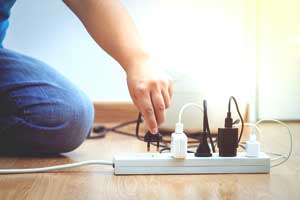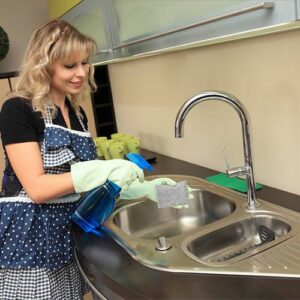Property and home care is no easy task. There are so many things happening, that it’s difficult to keep up even if you do it full time. One of the biggest issues homeowners face is water damage due to flooding or roof leakage.
In this article we’ll discuss 8 signs of water damage and why it’s important to notice it early.
Dealing with natural disasters and sewage back-ups – you are not alone
When disaster strikes, there’s flooding, hale hits your home and the roof starts leaking, water damage is almost certain. Such situations can not only be dangerous, but also quite disruptive to the tranquility of your life.
These are the obvious types of water damage which are easy to detect. The not so obvious ones can be noticed later on, with leakage starting from a small place, but expanding and causing serious property damage.
First signs of water damage
The very first signs of water damage are always airborne smell and moisture related.
Dampness, especially old sources have a recognizable musty smell to them. Newer sources may not smell so much, however, you will be able to feel it in the air around you.
If you live in a timber-framed property, it’s most likely that your walls are covered in painted dry wall. In cases of roof leakage, you’ll notice damp and discolored spots on your walls.
The paper and plaster in plasterboard are quite absorbent and have little to no resistance to water.
While water damage will not drastically affect its performance immediately, over the course of 24 hours drywall will start losing its grip and might slide of the screws that hold it in place.
The expansion and contraction of drywall due to moisture gathering and drying will dramatically affect any paint and jointing on the wall.
Even if you don’t notice the cyclical accumulation of moisture, you will definitely see the results of its action.
1. Wallpaper is peeling off
 When wall paper starts peeling off, you are sure to find moisture underneath or behind that wall.
When wall paper starts peeling off, you are sure to find moisture underneath or behind that wall.
Most wallpaper adhesive is water based and will liquefy once it gets water on it.
While it’s not a pleasant sight, it is at least noticeable.
It allows you to act on an early stage to prevent additional damage to your house.
2. You sense moisture into the air
Unless you are in a room which is meant to be damp, like a bathroom or a wash room, this means you have water seepage from an unknown source.
Air molecules can disperse H2O particulates and this can be felt on your skin, eyes, inside your nose and in your lungs.
This detection, while primitive, does not require any equipment and is on your person at all times.
Trust your body and you might save yourself quite a lot of trouble in the form of mold growth.
3. Mold is growing on certain places
Mold feeds and thrives through moisture.
While most types of mold are harmless, there are some like “black mold” which carries toxins.
These toxins can badly affect your health, resulting in muscle pain, respiratory discomfort, allergies and headaches.
If you see mold growing, then you know that there is excess moisture around that location or in the air. This can, and in most cases, is due to a source of water, bad air circulation or water leakage from sinks, roofs and around windows.
4. There are dark spots on your walls after water damage
Darks spots, which seem similar to soot or dirt, can be caused by water damage to your wall. It’s paramount that the source of this water is found otherwise the problem can spread to other areas of your property.
Dark spots can be due to the development of mold cultures and the discoloration of paint and fixtures will be a result of the feeding of said fungi.
5. The air feels heavy
Heavy air is a particular and sure sign of water damage and leakage.
Due to the weight of water molecules, with a significantly larger size than O2 particles, you will feel your lungs getting heavier and you will find it a bit harder to breathe.
This will be similar to coming out of the shower, being in Florida or in a sauna. If there’s water in the air, then it means that there’s some form of evaporation happening, which should be a cause for concern.
6. Electrical problems
While this is not that obvious, if you are having electrical problems, this might be due to water damage and water leakage inside your walls.
 If a particular light fixture is experiencing problems you should call for an electrician to check and see where the origin of the issue lies.
If a particular light fixture is experiencing problems you should call for an electrician to check and see where the origin of the issue lies.
Some light fixtures are mounted in such a way that allows for the intrusion of water into its internals.
While it might not short out, it may cause serious problems in electrical conductivity resulting in lower productivity.
If you have been through a storm or heavy showers, and you are experiencing electrical issues, there is a high chance your roof is compromised.
7. Water pressure is steadily dropping
Water damage due to plumbing problems is all quite too common. One of the first signs of pipe bursts is the reduction of water pressure.
In these circumstances you should call your municipal water company and check to see if there is scheduled maintenance causing these issues or it’s something in your particular property.
If it’s a problem with your plumbing then you should call a plumber immediately, otherwise water damage can cause structural problems and might even damage the foundations of your house.
8. In case of water damage there’s condensation on your windows
Condensation happens when water carrying air molecules meet a cold surface.
The temperature difference between the hot air and the cooler window makes water vapor molecules heavier and deposits them onto the cold surface.
Dealing with water damage sources and the aftermath
There are many source of water damage, some may be natural like disasters and flooding, others can be due to equipment or infrastructure malfunction.
Either way, whenever you experience such a case, immediate reaction is required – better call a professional water damage restoration company to remove any excess water and check for mold growth.





